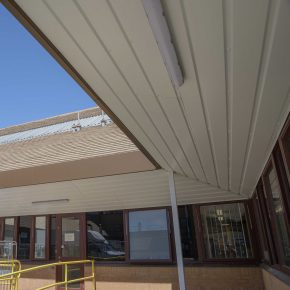
Why is engineered stone so popular for worktops?
As modular quartz gains popularity as a worktop choice, Stephen Moss, managing director of Maxtop Quartz Ltd, explains why more installers are opting for engineered stone instead of standard quartz or laminate.
No matter the sector, cost and time frame are often the central elements of any job. In order to keep costs low and installation on-track, it’s essential to consider the requirements of each individual project. Evaluating cost effectiveness, ease of installation and the durability of the materials used is the best way to make an informed decision. It’s this decision-making process that is putting composite surfaces, such as Maxtop Quartz, at the top of the wish list for specifiers and installers alike.
Cost effectiveness
When specifying materials, especially those involved in the latter stages of a build or renovation, it can be tempting to select lower cost products to ensure the project comes in under budget.
If the primary concern for a specifier is price, it used to mean that laminate or a similar surface was the go-to material for worktops. While laminate surfaces work tremendously well for many projects, composite surfaces can now offer many additional benefits.
For example, technological breakthroughs in modular quartz mean that surfaces are stronger, more durable and aesthetically-desired versus laminate, are available at a fraction of the cost of traditional quartz.
Some of these surfaces, including Maxtop Quartz, offer all the aforementioned benefits of quartz without many of the drawbacks, such as weight and long wait times from order to delivery. Technological advancements have made modular quartz lightweight and easy to cut in situ, making it perfect for budgets where high quality is essential, but stone is too expensive.
Specifiers are held accountable for the materials they select, therefore need to carefully consider the whole life cost and price of the materials they use, ultimately making the decision based on return on investment, rather than upfront. Essentially, making a decision based on value, rather than cost, is advisable. But this doesn’t always mean breaking the bank!
Ease of installation
As the old saying goes, time is money. This is just as applicable to worktop installation as it is to any other construction practice. The longer a project takes, the more it costs, particularly with regards to labour.
A simple installation reduces time spent on the project, placing importance on the worktop material specified once again.
Laminate’s lightweight properties make it easier to work with and the structure of the material means it is easier to cut vs stone surfaces.
Solid quartz worktops are of course heavy, therefore more difficult to lift, work with and even cut. While these surfaces may take longer to install vs lighter counterparts, the final result is reliable, strong and durable.
The argument that the quality of quartz outweighs the drawbacks of timely installation still stands, but it’s important that specifiers and installers don’t underestimate the alternatives on the market.
Modular quartz surfaces are lightweight and easier to install but still offer the same strength and durability that a solid stone surface would.
It’s not only the weight of the product that keeps labour costs low, but also the format and sizes that the stone is supplied in. With natural stone, it has to be supplied to the exact size of surface, meaning there’s no room for errors or miscalculations. This also means a long wait between placing an order and it arriving on site. With modular quartz, it can be supplied in different and often smaller panel sizes so can be cut in situ, to ensure it perfectly fits the space and can be supplied straight from stock to site, reducing time wastage.
Durability
Not only does the clever engineering of the modular product make it lighter and easier to install, but it also improves its durability. With many surfaces, the core layer gives the worktop an edge that traditional quartz doesn’t have. It creates enhanced impact resistance, which is beneficial both in the installation of the worktop and throughout its lifetime.
The quartz layer also shares a distinct advantage with traditional quartz, in that it is very difficult to scratch or damage, so if installed correctly, it should look pristine and remain that way throughout its life cycle.
Ultimately, the popularity of modular quartz is due to the fact that they can drastically reduce the two biggest concerns of specifiers, time and cost, whilst maintaining the beautiful aesthetic desired by the end customer.
Latest news

26th April 2024
Alumasc Skyline and Rainwater package specified at Weston-super-Mare Hospital
A package of products from Alumasc Water Management Solutions (AWMS) has been used for the external refurbishment of the roofline at Weston General Hospital in Weston-Super-Mare.
Posted in Aluminium Products, Articles, Building Industry News, Building Products & Structures, Building Services, Building Systems, Case Studies, Cladding, Drainage Services, Drainage, Guttering, Soffits & Fascias, Fascias, Restoration & Refurbishment, Retrofit & Renovation, Roofs, Walls
26th April 2024
Hush Acoustics optimises fleet operations by securing FORS Gold accreditation
Hush Acoustics has invested in the safety and sustainability of its commercial vehicle fleet by achieving Gold status in the Fleet Operator Recognition Scheme (FORS).
Posted in Acoustics, Noise & Vibration Control, Articles, Building Industry News, Building Products & Structures, Building Regulations & Accreditations, Building Services, Ceilings, Facility Management & Building Services, Floors, Health & Safety, Insulation, Restoration & Refurbishment, Retrofit & Renovation, Site Preparation, Sustainability & Energy Efficiency, Walls, Waste Management & Recycling
26th April 2024
Safeguard Europe: Penetrating damp - how to diagnose the damage
As Safeguard gets ready to deliver another informative session of one of its most popular webinars, the company outlines some of the most common reasons for rain penetration through brickwork.
Posted in Articles, Bricks & Blocks, Building Industry Events, Building Industry News, Building Products & Structures, Building Services, Continuing Professional Development (CPD's), Damp & Waterproofing, Facility Management & Building Services, Information Technology, Posts, Render, Restoration & Refurbishment, Retrofit & Renovation, Seminars, Training, Walls
25th April 2024
ADSA: Competence Initiative Makes Progress
The Joint Competency Initiative (JCI), in which the Automatic Door Suppliers Association (ADSA) is involved, is finalising its first framework for installers within the door, gates and shutter industry.
Posted in Access Control & Door Entry Systems, Architectural Ironmongery, Articles, Building Associations & Institutes, Building Industry Events, Building Industry News, Building Products & Structures, Building Regulations & Accreditations, Building Services, Continuing Professional Development (CPD's), Doors, Facility Management & Building Services, Health & Safety, Innovations & New Products, Publications, Research & Materials Testing, Restoration & Refurbishment, Retrofit & Renovation, Security and Fire Protection, Site Preparation
 Sign up:
Sign up: